Tavern Music
by Ed Crews
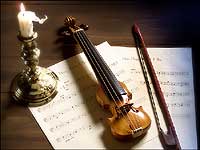
The pocket fiddle, small enough to easily bring to a musical gathering, was a mainstay of tavern tunes. This is a reproduction.
The crowd at Chowning's Tavern is ready to relax after a day of touring Colonial Williamsburg's Historic Area. Customers are talking, drinking, and cracking open peanuts. Most don't notice when John Turner enters the candlelit room clad in colonial garb, carrying his fiddle. But, when he begins to play eighteenth-century selections like "Highland Laddie" and "The Fly," the talk trails off and the patrons give him their full attention.
As he has for decades, Turner coaxes a lot of emotion from his fiddle and his audience. People become subdued when he plays a lament. They are engaged completely, clapping hands and tapping feet, when he tears into a lively dance tune. Invariably, they applaud when he finishes a song.
Turner's spirited, expert performance and the audience's warm response show why tavern music programs have endured in Colonial Williamsburg since the late 1950s. These intimate performances share with guests the music that ordinary colonists sang, danced, and listened to in taverns, at home, and on the street. These selections ranged from traditional ballads and hymns to bawdy, romantic, political, and humorous songs. They provide another means of understanding eighteenth-century America. Today, evening guests can hear this music in the Historic Area at Chowning's Tavern, Christiana Campbell's Tavern, King's Arms Tavern, and Shields Tavern.
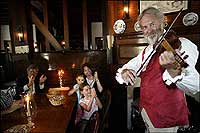
John Turner, Colonial Williamsburg interpreter and master of a dozen instruments, fiddles tunes of the times at Chowning's Tavern.
For Turner, Colonial Williamsburg's senior tavern entertainer, this work is a labor of love and the product of a lot of research. He grew up in a house filled with music. His father and grandfather played the fiddle. Turner began lessons at age five and turned teacher at fifteen. He has mastered eleven more instruments, including bagpipes and recorder.
Turner started playing in the taverns in 1974. Over the years, he has researched early American music through Colonial Williamsburg's resources, as well as at the Library of Congress and in Scotland.
Many of the tunes found, learned, and presented by Turner and other Historic Area performers have faded from the nation's cultural memory. Some, however, come to modern Americans in childhood and linger a lifetime.
"I frequently ask people if they have any requests for eighteenth-century songs," Turner said. "They assume that they don't know any. Yet most people do know some songs from the period even if they aren't aware that they do."
Although somewhat altered in content and meaning, well-known surviving songs include "Three Blind Mice," "Pop Goes the Weasel," "The Bear Went over the Mountain," "Twinkle, Twinkle, Little Star," and, of course, "Yankee Doodle."
Colonial Williamsburg's taverns are a logical site to perform the music familiar to ordinary colonists of the 1700s. Historical evidence shows that dancing and singing were integral to tavern life in British North America. Trained musicians did play at inns, and patrons did sing to entertain themselves. What they performed is less well known. Historical records don't say much about specific selections. Turner said there was not a class of tunes specifically known as tavern music.
Americans of that period loved song and dance, and taverns were important in eighteenth-century public life. Nothing in twenty-first century America is comparable. Taverns of the 1700s were partially museums, gentlemen's clubs, circuses, schools, and business offices. They were the grandfather of the nineteenth-century saloon, and the great-grandfather of the modern American nightclub.
In eighteenth-century America, taverns were also called inns, ordinaries, and public houses. Found in rural and urban areas, they primarily provided overnight lodging for travelers. Owners usually served alcoholic beverages and sometimes meals. Colonial governments heavily regulated inn operations, but quality varied greatly.
"Taverns in early American ran the gamut from the elegant to the mean and nasty, from those that catered to every need of society's elites to those that the locals and travelers who used them could only hope to survive," wrote Sharon V. Salinger, a University of California history professor, in her book Taverns and Drinking in Early America.
Despite the variety, a generalization holds true. Inns were male domains. The places could be rough-and-tumble. A Virginia minister in 1751 described patrons as "lazy," "dissolute," and "the very Dreggs of the People." Customers drank heavily. Foul language was commonplace. A diarist said that even in a fine Philadelphia establishment patronized by leading citizens "some persons there showed a particular fondness for introducing gross smutty expressions."
Gambling was widespread. Patrons could participate in raffles, and card and dice games, and bet on cockfights and horse races. Felons planned crimes, fenced goods, and passed counterfeit money in inns. Fights and murders were common.
Prostitutes frequented taverns; respectable ladies avoided them. Women travelers, however, sometimes had to stay at an inn. That required vigilance, wrote diarist Hannah Callender Sansom. Apparent male warmth always disguised the "basest views," she said.
Besides pursuing vices, customers enjoyed other diversions. Inn owners typically did not hire performers, Turner said. Instead, entertainers came to taverns, hoping grateful patrons might pass the hat for them. Public houses welcomed actors, magicians, and deformed individuals. Animal acts were popular, Turner said. Records mention displays of a camel, moose, baboon, leopard, and trained pigs.
Music was just part of the tavern entertainment mix.
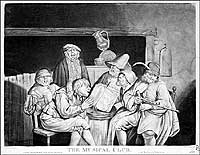
The glee in this club was perhaps improved by beer and spirits, but music made for entertainment and companionship in taverns.
Sometimes a professional musician performed free-lance. The talents of these entertainers varied. For example, an advertisement from New York touts a violinist who could sing and do animal imitations. A diarist in 1744 mentioned hearing another singer whose voice was too big for the small inn he visited.
If a professional musician was unavailable, guests might perform for their own amusement. Homemade music was common in eighteenth-century America, Michael Saffle said. He teaches arts and humanities at Virginia Tech's Center for Interdisciplinary Studies, has a doctoral degree from Stanford in music and humanities, and has a long-standing interest in early American music.
"People sang their own songs, often played and even made their own very simple instruments. Keyboard instruments were rare. Violins were more common. People also owned flutes, occasionally trumpets and other wind instruments," Saffle said.
Some tavern owners kept instruments for these occasions, Turner said. A colonial inventory of Williamsburg's Shields Tavern shows instruments on hand. The nearby Raleigh Tavern had a harpsichord. Any guest who provided his own accompaniment probably relied on something light and portable, like a flute or a violin, Turner said. Period instrument makers sold a special traveling violin—a pochette—so small it could fit in a coat pocket.
Of course, inn patrons always could fall back on their voices. There was group singing. It was not merely about making communal music, however, according to historian Peter Thompson in his book Rum, Punch and Revolution: Taverngoing and Public Life in Eighteenth Century Philadelphia. Toasting and singing were means of drawing together people from disparate backgrounds, Thompson wrote, though the gambit didn't always work.
"Neither practice was entirely effective, not least because a ïtypical' tavern company often contained men who did not want to be drawn into enforced intimacy with the dominant crowd," he wrote. "For this reason, the very forms by which taverngoers attempted to overcome their differences could also become the occasion of division and contest."
Lutheran minister Henry Muhlenberg describes just such a situation during 1752 in a New Jersey tavern. The minister refused to join in a songfest and dared to criticize certain romantic songs, which earned him abuse from other patrons.
So, what songs did people sing in taverns? Few references to specific tunes survive. Odds are good, though, that whatever people sang, their tunes originated in the British Isles.
"An ocean separated early English-speaking settlers from the land of their origin, but not from its language, ideology, popular beliefs, proverbs, verses, or music," wrote University of Michigan professor Richard Crawford in America's Musical Life: A History.
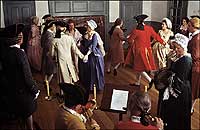
For the high and the low, entertainment meant music—here, by professional musicians at a well-heeled and lightly trod ball.
According to Crawford, two rich sources of music in British North America during the 1700s were traditional songs and broadside ballads.
By the eighteenth century, traditional songs had been passed orally from generation to generation. Children often learned these songs from parents and grandparents, and, as adults, taught them to their children. Although the origin and creators were largely unknown, traditional songs survived for decades and sometimes for centuries.
Though the oral transmission of these songs was a powerful force in the 1700s, there also was interest in preserving them in written form. Individuals collected them and published anthologies of traditional music. Thomas Jefferson shelved some of these works in his music library. Music for drinking songs, country dances, and English, Scottish, and Irish airs rested near works by Vivaldi, Handel, and Haydn. Jefferson also liked playing fiddle tunes heard at local gatherings, according to historian Gilbert Chase in America's Music: From the Pilgrims to the Present.
Particularly popular in Virginia in the 1750s and later was Scottish music, Turner said. Scottish music was in vogue in London during the period. Virginians who wanted to keep up with current English fashion eagerly embraced these tunes. In his later years, George Washington developed a fondness for these songs and encouraged his granddaughters to perform them for him. Scottish music also was enjoyed by the many Scots who settled and worked in Virginia.
Traditional songs touched on all sorts of topics. To appreciate the variety, consider three ballads Benjamin Franklin described as widely known in a 1765 letter to his brother: "Chevy Chase," "The Children in the Woods," and "The Spanish Lady." "Chevy Chase" tells of a bloody fight between knights. "The Children in the Woods" is a tale about the death of two young orphans caused by their uncle's greed for their inheritance. "The Spanish Lady" reveals the sufferings of a Spanish woman captured by English soldiers. She falls in love with one of her captors, who already has a wife and abandons his smitten prisoner for her.
Unlike modern popular songs, eighteenth-century ballads could be long, running to about twenty stanzas, Turner said. None could be omitted because all were required to tell the story.
Another source of popular songs was the broadside ballad, according to Crawford. The name derived from the sheets of paper on which they were printed. Topics ranged from current and historical events to crime, love, and religion. The growing split between colonists and Great Britain was a source of broadside songs in the second half of the eighteenth century, and traditional ballads found their way onto broadsides. Broadsides often provided the words to a song, possibly an illustration, and, at times, directions to sing the words to a well-known tune.
In theory, anybody with a yen to compose songs and the money to pay for the printing could publish a broadside song. Their presence, however, does not mean that a colonial Tin Pan Alley or music industry churned out ditties for eager public consumption, Virginia Tech's Saffle said.
"Even in the United States or colonial America of the eighteenth century there was no such thing, strictly speaking, as popular music. That term means several things, but one important one has to do with a ïpopular' or mass audience," he said. "And there simply wasn't one in the colonies then."
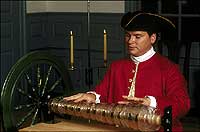
Dean Shostak plays melodies on the glass armonica with moistened fingers on glass bowls or glasses spun by a wheel.
The booming sale of sheet music would not begin in earnest until the nineteenth century, and truly mass-market music would have to wait until the invention of the phonograph and radio.
Besides singing, taverns occasionally featured dancing. This reflected a widespread love of dance, which touched every social class in Virginia, Turner said. Because dancing meant bringing women into a male arena, some owners made accommodations to female sensibilities. Wetherburn's Tavern in Williamsburg added a room just for dances, with a lady's entrance that allowed them to avoid the bar.
Although Colonial Williamsburg guests come from one of the most musically saturated cultures in history, they often are intrigued and entertained by the music Turner and his colleagues play in the taverns. Turner has found some songs strike an especially responsive chord. "I Once Loved a Lass," for example, tells of unrequited love. "Leezie Lindsay" tells of love triumphant. "Nottingham Ale" is a rousing drinking song. Sing-alongs are broadly popularly, especially among families with children.
Though Turner enjoys performing and guests enjoy listening to him, he said that the music of Colonial Williamsburg's taverns does more than add a little entertainment to a visit. He said the tunes offer another way to see and to understand the American colonists.
When he can, Turner uses songs to illuminate eighteenth-century attitudes and events. For example, asked to play "Highland Laddie," he also will discuss the English repression of Highland culture following Scottish rebellion in the 1700s. Although the English banned bagpipes, native and expatriate Scottish fiddlers mimicked their sound as a form of protest.
Turner said: "The music can tell us a lot." It reveals to us, in a way that text or lectures cannot, the joys, fears, heroes, virtues, vices, politics, and aspirations of the ordinary men and women who lived two centuries ago.
Sound
clip from the CD "Nottingham
Ale: Tavern Music from Colonial
Williamsburg".
Purchase this CD
Singing and merriment in a colonial tavern.
Ed Crews contributed to the autumn 2003 journal a profile of General Cornwallis and an article on Colonial Williamsburg's coopers. His story on Colonial Williamsburg's Geddy Foundry appears elsewhere in this issue.
